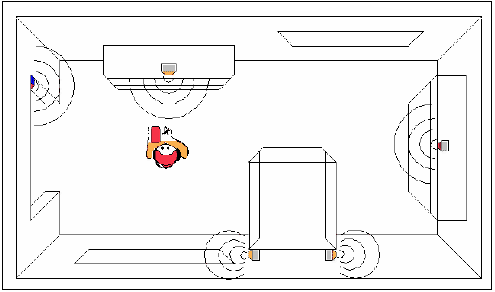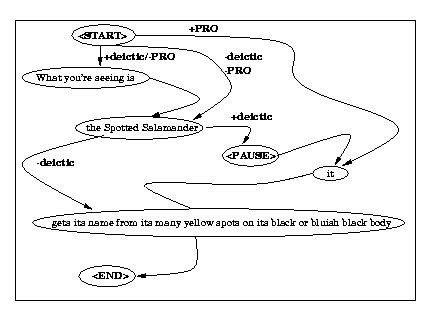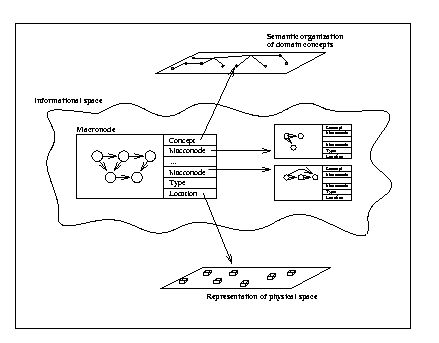
Figure 1: A visitor exploring an augmented room in a museum. (full size, 8k)
Elena Not, Massimo Zancanaro
IRST/ITC - Cognitive and Communication Technology Division
38050 Povo - Trento -Italy
phone: +39-461-314444
{not,zancana}@irst.itc.it
Find a postscript version here (gzipped, 56k)
Abstract: The most important new issue emerging when allowing the fruition of a hypermedia repository of information while the user is moving in a physical space is the fact that information is presented in different situational contexts. Also, an additional perceptual dimension comes into play, providing stimuli, attention grasping and feedback. Emphasis should be put on integrating the perceptual experience with helpful information, without competing with the original exhibit items for visitor's attention.
In this paper we shall discuss some of the critical issues about content adaptation emerging in physical hypernavigation, presenting the approach adopted in the HyperAudio project.
Keywords: content adaptation, physical hypernavigation
New hardware technology allows the fruition of virtual repositories of information while enjoying the physical space: for example, kiosks or portable devices may allow the access to a portion of a virtual information space relevant for the object in front of the visitor.

Figure 1: A visitor exploring an augmented room in a museum. (full size, 8k)
Figure 1 suggests one possible scenario of this kind, where visitors of a museum or an exhibition may enjoy a personalized tour through the interaction with the physical space augmented with an overlapped synchronized informational hyperspace (we will call this interaction context a physical hypernavigation). Each visitor is equipped with a palmtop computer endowed with headphones, on which an infrared receiver is mounted. Each meaningful physical location has a small (power-autonomous) infrared emitter, sending a code that uniquely identifies it.
Exploiting the infrared signals, the system is able to identify when the visitor reaches a certain physical location and can activate a relevant portion of the information repository loaded on the palmtop. Meaningful information are selected and organized to be played as audio messages or displayed on the palmtop screen. Adaptive and dynamic hypertext technology can be exploited to tailor a presentation according to the visitor interests, the actual context of the visit and so on.
We are currently investigating the features of this scenario inside the HyperAudio project [Not et al. 1997], a project IRST is developing in collaboration with the Civic Museum of Natural Sciences in Rovereto (Italy). The results gained inside HyperAudio will contribute to more advanced research efforts towards a richer interaction scenario, to be explored jointly with other partners inside the HIPS European project[*].
Navigating in a physical hyperspace is quite different from browsing an electronic book or a traditional (even adaptive) hypermedia running on a stationary console. The cognitive problems that may arise when a person is moving in a virtual information space (e.g., being lost in the hyperspace or the cognitive overload, [Conklin1987]) are different from those of a person moving in a real space, since an additional perceptual dimension comes into play, providing stimuli, attention grasping and feedback.
In this paper we shall discuss some of the critical issues about content adaptation emerging in physical hypernavigation. We shall particularly focus our discussion on the museum environment, which introduces additional stimulating challenges for effective content adaptivity.
The problem of adapting content for (cultural) information presentations in physical hypernavigation shares many features with the problem of producing adaptive and dynamic hypermedia for virtual museums (e.g. [Mellish et al. 1997]) or dynamic encyclopedias (e.g. [Milosavljevic et al. 1996]), as confirmed by many psychological studies made on museum visitors. For example: information should be stated in terms the visitor can understand (adaptation to expertise/knowledge level) and should help the visitor connect the new information to what he already knows ([Hood1993]); information should include references to visitor's interests ([Serrell1996]); content should be provided in a form that best stimulates learning on the part of the hearer ([Serrell1996]).
However, content adaptation in a physical environment poses some original problems which are related to the fact that the visitor is experiencing a ``real'' situation: moving in a real environment, looking for concrete objects to observe, and receiving perceptual orientation feedback. The peculiarity of inserting a hypertextual structure onto a physical space generates new ways of navigating information:
When assembling information presentations the system should take into account the prominence of the situational context, integrating the perceptual experience with helpful information, without competing with the original exhibit items for visitor's attention:
It may be argued that nowadays virtual reality technology allows the realization of virtual museums in which visitors navigate in a synthesized 3-D environment. Many of the issues above are relevant to this scenario too. However, the human computer interaction in augmented space is still substantially different at least for the presence of physical fatigue associated to movement.
The most important new issue emerging when allowing the fruition of a hypermedia repository of information while the user is moving in a physical space is the fact that information is presented in different situational contexts. The main factors determining the situational context are (i) the user position and movements (whether he is in front of an object or whether he is simply walking around a room); (ii) the structure of the surrounding physical space; (iii) whether other people are examining the same item or not; (iv) whether the user came alone or not. Even though mobile computing nowadays allows to access hypermedia while the user is moving in the physical space (as in the case of a visitor walking around a museum and browsing on his palmtop computer the museum's web pages ), existing systems do not offer real dynamic adaptation with respect to the situational context.
A system effectively supporting physical hypernavigation should integrate the individual, dynamic modeling of the user (his knowledge, interests, goals, integrated with abilities, attitudes and preferences) with a general model of the environment, of user's movements and user's social context.
In a traditional hypermedia, where the user is typically expected to browse around and read written information, though enriched with images and sounds, the system can hardly be sure that the user has really read (let alone assimilated [Mellish and O'Donnell1998]) the message. Permanence time associated to hypertext pages is usually not significant, unless some additional feedback is exploited (e.g. mouse moves).
When the audio output modality is available, combined with a position locating system tracking the user movements in the physical space, more information can be inferred about how the user is receiving the messages. For example, if the user is standing in front of the object currently described by the system and does not explicitly stop the presentation or does not move, the system could guess a high assimilation score.
But even if audio output could be a plus, we must be careful not to waste the positive aspects of this resource. In fact, if message content is not properly adapted to the audio modality the risk occurs of introducing an additional disorientation effect or dissatisfaction in the user. This phenomenon is more evident here than in traditional hypermedia because the user can not skip uninteresting or unsuitably tailored information as easily as in a hypertext.
In HyperAudio, information presentations are built by the system and are provided to the visitor whenever he reaches meaningful locations or when he explicitly asks for information. Each presentation is a structure containing (i) a sequence of audio files which will be played through the headphones, (ii) a set of relevant concepts worth of further elaborations which will be depicted on the display as clickable buttons, and possibly (iii) images related to the object or concept described and a properly oriented map displaying the visitor's current position.
The audio presentations are built concatenating precanned audio files selected from the informational space. In HyperAudio, the informational space is designed so that its contents and its structure can be used in an adaptive way. The information unit is the macronode (see fig. 2). Each macronode includes a network of audio files, a list of pointers to other relevant macronodes (including the particular rhetorical relations between them), the type of text (e.g., general introduction, detailed description, ...), a pointer to the relevant semantic concept in the ontology, and possibly a link to a physical location for which the message would be pertinent.

Figure 2: Sketch of macronode network (full size,5k)
More than one macronode can be selected to build the actual presentation. A macronode is atomic with respect to its content but it can have some optional parts that are selected only in some particular discourse contexts. For example, the macronode audio file network in figure 3 can be instantiated in the following messages:

Figure 3: The audio files network for the Spotted Salamander macronode
(in the figure, each circle in the network represents an audio file or a command to the audio player). (full size, 3k)
An audio file network encodes lexical variations of the same message (that means that whatever instantiation you choose, the content of the text is the same). The task of instantiating a network performs in a simplified way some of the choices typically performed by the tactical component of an automatic natural language generator.
An important piece of information included in the macronode is the type of the message stored in the audio file network. Borrowing from [Serrell1996], we have defined the following message types occurring in the museum setting:
The type describes the purpose of the message and it is exploited in the decision process aimed at building communicatively effective presentations (as discussed below).
Another important information contained in a macronode is the set of macronodes semantically related to the current one. For each related macronode the kind of connecting relation is also indicated. At present, we are using a limited set of relations to capture the ways in which follow-up information to caption add information to a caption message: among others we consider elaboration-general for general new information, elaboration-part for part-whole descriptions (it is useful in natural science domains), elaboration-legend for legends, anecdotes, and so on.
Each time the system has to describe a concept, it collects all the macronodes which refer to that concept and exploits a set of heuristics to decide what macronodes have to be discarded, what have to be played as the current audio presentation (and in what order) and what will be realized as textual anchors on the screen. Some of the heuristics are similar to those used by other adaptive systems, exploiting the user knowledge model (for example to select comparisons to already known concepts or introducing explanations for unfamiliar terms), the user interest model (to stress user preferred topics), discourse history (both to not select macronodes already presented and to introduce references to already seen objects)[Mellish and O'Donnell1998].
Other heuristics are more specific for the task of hypernavigation in physical space. For example, adaptation to the physical situation (discussed in section 2.1) can be addressed by:
In order to maximize the communicative efficacy of the presentations, we have implemented a set of heuristics that constrain the ordering and the type of messages that are concatenated in a single audio presentation. For example,
The length of audio presentations should be carefully constrained: presentations based on captions should be short (relying on the visual anchors on the screen if the visitor needs more information), presentations based on section labels can be longer. Way-finding and orientation messages should be very short when associated with other messages while can be longer when they represent the primary goal of the presentation.
Even though we focussed our discussion on the museum setting, many of the critical issues discussed in this paper about content adaptation beyond the traditional stationary hypermedia setting do apply to any physical hypernavigation setting (e.g. being guided in tourist/cultural sites, in airports or in complex buildings).
We are currently designing a set of experiments with real users both in a laboratory setting and in the Civic Museum in Rovereto in order to test the validity of the proposed heuristics as well as the user acceptability of HyperAudio.
We wish to acknowledge the contribution of the other members of the HyperAudio team (Gregorio Convertino, Daniela Petrelli, Marcello Sarini, Oliviero Stock and Carlo Strapparava) to the discussion of the ideas presented in this paper. In particular, many thanks to Marcello Sarini and Carlo Strapparava for useful comments and suggestions on previous versions of this paper. Valuable input was also provided by the discussions with the other members of the HIPS consortium.
[Bitgood and Patterson1993] Stephen C. Bitgood and Donald D. Patterson. The effects of gallery changes on visitor reading and object viewing time. Environment and Behaviour, 25(6), November 1993. Special Issue on Environmental Design and Evaluation in Museums.
[Boisvert and Slez1994] Dorothy Lozowski Boisvert and Brenda Jochums Slez. The relationship between visitor characteristics and learning-associated behaviours in a science museum discovery space. Science Education, 78(2):137-148, 1994.
[Conklin1987] Jeff Conklin. Hypertext: An Introduction and Survey. Computer, Survey & Tutorial Series, 1987.
[Finn1985] David Finn. How to visit a museum. Harry N. Abrams, Inc. Publishers, 1985.
[Hood1993] Marilyn G. Hood. Comfort and caring: Two essential environment factors. Environment and Behaviour, 25(6), November 1993. Special Issue on Environmental Design and Evaluation in Museums.
[Mellish and O'Donnell1998] Chris Mellish and Mick O'Donnell. An architecture for opportunistic text generation. In Proceedings of the 9th International Workshop on Natural Language Generation, Niagara-on-the-Lake, Ontario, Canada, August 1998.
[Mellish et al. 1997] C. Mellish, J. Oberlander, M. O'Donnell, and A. Knott. Exploring a gallery with intelligent labels. In Proceedings of the Fourth International Conference on Hypermedia and Interactivity in Museums (ICHIM97), Paris, September 1997.
[Milosavljevic et al. 1996] Maria Milosavljevic, Adrian Tulloch, and Robert Dale. Text generation in a dynamic hypertext environment. In Proceedings of the 19th Australasian Computer Science Conference, Melbourne, Australia, 1996.
[Not et al. 1997] Elena Not, Daniela Petrelli, Oliviero Stock, Carlo Strapparava, and Massimo Zancanaro. Person-oriented guided visits in a physical environment. In Proceedings of the Fourth International Conference on Hypermedia and Interactivity in Museums (ICHIM97), Paris, September 1997.
[Sarini and Strapparava1998] Marcello Sarini and Carlo Strapparava. Preliminary notes for a user model in a museum exploration and information-providing adaptive system, 1998. IRST Internal report.
[Serrell1996] Beverly Serrell. Exhibit Labels. AltaMira Press, 1996.